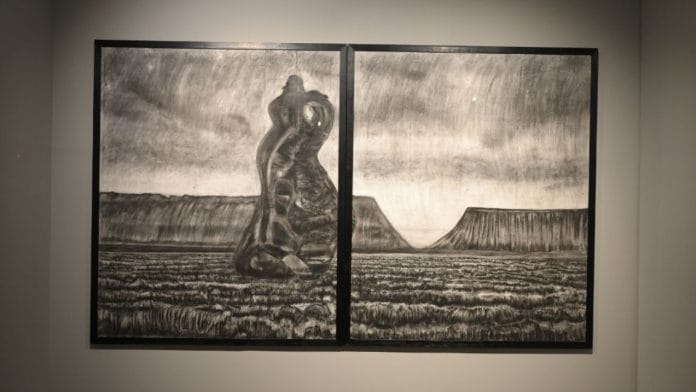New Delhi: A coal miner in tattered clothes, covered head to toe in black dust, gazes at the burning coalfields where apricot-orange flames leap from the ground in swift, singular bursts. This is filmmaker and photographer Ronny Sen’s gaze as he captures the coalfields of Jharia, Jharkhand, using the blunt, oblique perspective of his lens.
The photograph is part of the ongoing exhibition, ‘Tales from The East: Embers, Echoes, and Stories of Shifting Earth’ at Exhibit 320 in Delhi’s Saket. Curated by Prayag Chakradhar, the exhibition investigates the “fluidity of urban topographies”, the “realities of mineral procurement”, and histories of labourers, miners, and workers. In this almost apocalyptic chaos, there is beauty as well.
Sen’s photograph, for instance, which was part of his 2014 solo exhibition, ‘Fire Continuum’, was shot at twilight, when the sky was awash in shifting hues of purple and blue. It forces the audience to confront and acknowledge the harsh realities of the coalfields of Jharia that power the light in our homes.
Chakradhar selected artwork of decaying objects, and changing landscapes for this exhibition. Photographs by Sen, installations by Sareena Khemka, and charcoal paintings by Musa, among others, narrate a well-stitched story on the plight of migrant workers and the adversity of the environment.
“I have been familiar with their works for a very long time and that’s how the idea started formulating. The need to share the sufferings of the marginalised section and environmental degradation played a catalyst,” said Chakradhar.
Setting the tone
The urban spaces are ever-evolving; there is construction, de-construction, little preservation, and decay.
‘Tales From The East’ takes a close look at how economical and physical exploitation leads to migration. Artist Sareena Khemka’s artwork — mixed media paintings with casted concrete, cast cement, scrap metal, terracotta tiles, and resin — sets the tone.
Having lived in several large metropolitan cities such as Chicago, Kolkata, Mumbai, and Bengaluru, Khemka is drawn toward the architecture of spaces. She uses materials like cement, papercrete, scrap metal, and resin, challenging the viewers to consider the dichotomies of construction and destruction.
Copper is a recurring colour in her work.
“It symbolises the tarnish and decay that cities undergo if not preserved,” said Chakradhar.
Next to Khemka’s artwork, a dimly-lit hallway serves as the backdrop to Bangladeshi artist Mohd. Musa’s charcoal drawings, titled ‘My Village’. The series of drawings show how nature is supposed to be.
“His landscapes take you to that peaceful space or that memory you have of a place where — the land is green; the land is untouched,” Chakradhar said.
He uses charcoal effectively to recreate memories of his village in Bangladesh. The choice is deliberate–charcoal reflects the transient nature of existence.
“He is a very young artist. He just completed his graduation. It is difficult to place this artwork alongside his age,” the curator said.
Also read: What’s missing in the new Humayun Museum of Mughal history? A key decade of India
Trash for one, treasure for another
If Musa is about roots and home, then mixed media artist Survakanta Swain is about movement and transition. Having grown up in Cuttack, Odisha, he moved to Delhi in 2000 with the intention of becoming an artist. He dedicated 20 years to his craft which is tinged with his experience of the rootlessness of urban life.
Like the other artists, Swain, too, uses typical ‘urban material’ in his mixed-media work. There are bricks, cement bags, and metal rods to document and narrate the lives of migrant workers and the environment they inhibit.
“My craft has a glimpse of craftsmanship because it is something I have observed in my village growing up. It has left a significant impact on me,” said Swain.
In one of his pieces titled ‘Memory of found objects’, he uses discarded or rather broken parts of wood, generally used as armrest in chairs or small domes on the corners of beds.
“We would never discard it, instead, we would make full use of it in some way or the other. But, here, if it’s slightly broken, it becomes trash,” Swain said.
His art prompts the viewer to reflect on the ambiguous nature of urban life. For Swain, when it comes to art, “the job is never satisfying,”.
“I look at my work and still feel there is an area of improvement,” he said.
Swain explained that if the foundation, which is the core idea of the art, is strong, the artist focuses on how to elevate it using the technicality of craft.
“That’s how artists become masters,” he added.
Chakradhar took six months to build this curation. Even after he gathered the works of young talent, he couldn’t satisfy that niggling itch—it was not complete. The final selection for the exhibition was from his personal collection. His father, Ajay Chakradhar’s ‘Canary in a coal mine’ was the missing piece.
The artwork — mica, manganese, and acrylic on canvas — delves into the politics of mining in Jharkhand, revealing the governance issues, labour exploitation, and environmental degradation associated with this industry.
“But, I never saw the artwork from the lens of a son, my eyes have always been that of a curator. I see the artist in him, not the father.”
(Edited by Aamaan Alam Khan)






